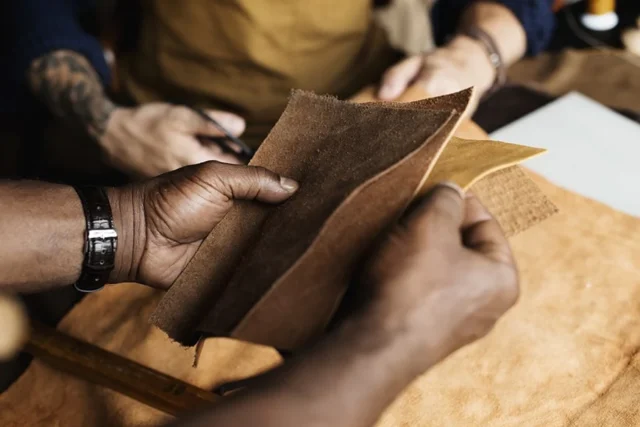Discover the enduring allure of Handmade Leather Bags through our exploration of timeless traditions and craftsmanship. Experience the unique beauty, durability, and artistry that only comes with meticulously crafted leather goods.
Table of Contents
Introduction to Handmade Leather Bags
Handmade leather bags carry more than just your essentials; they carry a legacy of traditional craftsmanship and timeless elegance. Unlike mass-produced counterparts, these bags embody the meticulous attention to detail and the personal touch of their creators, making each piece unique.
The Art of Leather Crafting
Tools and Techniques
The first step in the leather crafting process involves an array of specialized tools, each serving a specific purpose. From cutting knives, which must be sharp enough to cleanly slice through the leather, to stitching awls that pierce precise holes for sewing, the quality of these tools directly impacts the final product. Additionally, edge bevelers, burnishers, and stamping tools allow artisans to add intricate details and a polished finish.
The Leather Selection Process
Choosing the right leather is crucial. Artisans often opt for high-quality hides, such as full-grain leather, which includes the outer layer of the hide. This part boasts the most strength and durability. The selection process also considers the leather’s grain, texture, and ability to age gracefully, developing a unique patina over time.
Crafting Process
The crafting process begins with design and pattern-making, where artisans conceptualize their creations and lay out patterns on the leather. Precision cutting of the leather pieces is next, a meticulous task that sets the stage for the item’s overall look and feel.
Stitching and assembly are at the heart of leather crafting. Whether by hand or machine, this step requires immense skill to ensure durability and aesthetic appeal. Techniques such as saddle stitching, which involves two needles and a single thread, are often used for their strength and artisanal quality.
Finishing Touches
The final stage includes polishing, dyeing, and sometimes embossing or stamping the leather to add logos or decorative patterns. These finishing touches not only enhance the item’s beauty but also protect the leather, ensuring it lasts for years to come.
Cultural and Historical Significance
Leather crafting holds deep cultural and historical significance, with its origins tracing back thousands of years. Ancient civilizations valued leather for its durability and versatility, using it for clothing, footwear, and protective gear. Today, leather crafting reflects a blend of tradition and personal expression, with artisans infusing their cultural heritage and artistic vision into each piece.
Sustainability and Ethical Considerations
The modern leather crafting industry faces challenges related to sustainability and ethics. Artisans and consumers alike are increasingly prioritizing ethically sourced leather and environmentally friendly practices. This shift towards sustainability involves using vegetable-tanned leather, recycling scraps, and minimizing chemical use, ensuring that the art of leather crafting can continue for generations to come with minimal environmental impact.
The Making of a Handmade Leather Bag
Design and Pattern Making
The first step in creating a handmade leather bag is the design phase. Here, the artisan conceptualizes the bag’s appearance, functionality, and dimensions. This stage involves sketching the design and developing patterns that will be used to cut the leather. The patterns are crucial as they determine the bag’s shape, size, and how the pieces will come together.
Selecting the Leather
Choosing the right leather is pivotal to the bag’s aesthetics and durability. Artisans often opt for high-quality, full-grain leather, valued for its strength, texture, and ability to age gracefully. The leather’s color, thickness, and flexibility are also considered, ensuring it aligns with the bag’s intended design and purpose.
Cutting and Preparing the Leather
Once the leather is selected, the next step is cutting it according to the patterns created during the design phase. This requires precision to ensure each piece fits together perfectly. Edges may be thinned or skived to allow for easier folding or stitching, depending on the bag’s design.
Assembling and Stitching
The assembly phase is where the bag starts to take shape. Pieces are aligned and joined, often beginning with the bag’s larger sections before moving on to smaller components and details. Stitching is a critical part of this process, with many artisans opting for hand-stitching to ensure durability and strength. Techniques like saddle stitching, where two needles and waxed thread are used, are popular for their robustness.
Adding Hardware and Accessories
Hardware such as buckles, clasps, zippers, and handles are added to the bag. These elements are not only functional but also contribute to the bag’s overall style. Choosing high-quality hardware is essential for the bag’s longevity and aesthetic appeal.
Finishing Touches
The final stage involves finishing touches, such as edge painting, polishing, and conditioning the leather. These steps enhance the bag’s appearance and protect the leather, ensuring it remains beautiful over time. Artisans may also emboss or engrave the bag with a logo or decorative patterns, adding a signature touch.
Quality Inspection
Before a handmade leather bag is deemed complete, it undergoes a thorough quality inspection. This ensures that every stitch, cut, and embellishment meets the artisan’s high standards. It’s a testament to the craftsmanship and care invested in each piece.

Why Choose Handmade Leather Bags
Unmatched Quality and Durability
Handmade leather bags are synonymous with quality and durability. Crafted from high-grade leather, each bag goes through a meticulous process where every stitch and cut is placed with precision and care. Unlike mass-produced bags, where speed often compromises quality, handmade bags are built to last, aging gracefully and developing a unique patina over time. This longevity makes them not only a practical investment but also a sustainable choice in the long run.
Unique and Personal Touch
Each handmade leather bag is a work of art, infused with the personality and touch of its creator. The handcrafting process ensures that no two bags are exactly alike, offering a level of uniqueness that can’t be replicated by machine-made counterparts. This uniqueness allows individuals to express their personal style and taste, knowing that their bag is one-of-a-kind.
Sustainable and Eco-Friendly
Handmade leather bags often come from artisans who prioritize sustainability and ethical practices. Many use locally sourced, vegetable-tanned leather, which is less harmful to the environment compared to the chemicals used in traditional tanning processes. By choosing handmade, consumers support smaller scale production that typically has a lower carbon footprint, contributing to a more sustainable and eco-conscious fashion industry.
Support for Traditional Craftsmanship
Opting for a handmade leather bag means supporting artisans and the preservation of traditional craftsmanship. Leatherworking is an ancient skill that has been passed down through generations. By purchasing a handmade bag, you are helping to keep these skills alive and supporting the livelihoods of artisans who are dedicated to their craft.
Customization Options
Many artisans who create handmade leather bags offer customization options, allowing customers to have a say in the design, color, and features of their bag. This level of personalization not only makes the bag more tailored to individual needs and preferences but also enhances the connection between the artisan and the consumer, adding a personal story to each piece.

FAQs
1. How do I verify the authenticity of a handmade leather bag?
Authenticating a handmade leather bag involves examining the quality of the material, craftsmanship, and details. Genuine handmade bags often have a certificate or a tag indicating the artisan or workshop. Look for irregularities in stitching, which can indicate hand sewing, and the unique character in the leather grain. Additionally, buying directly from reputable artisans or authorized retailers can ensure authenticity.
2. Can handmade leather bags be customized?
Yes, many artisans offer customization options for handmade leather bags. Customization can range from selecting the type of leather, color, and hardware to engraving initials or specific designs. This allows for a personal touch, making the bag uniquely yours. It’s best to discuss directly with the artisan to understand the extent of customization available.
3. What makes handmade leather bags more expensive than mass-produced ones?
The higher cost of handmade leather bags reflects the quality of materials, time, and skill involved in their creation. Handmade bags are crafted from premium leather, requiring hours of labor-intensive techniques. This meticulous process, along with the exclusivity and durability of the product, justifies the higher price compared to mass-produced alternatives.
4. How often should I condition my leather bag?
The frequency of conditioning depends on the climate and how often the bag is used. Generally, conditioning the leather every 3 to 6 months helps maintain its suppleness and prevent cracking. However, if you live in a dry area or use the bag daily, you might need to condition it more frequently. Always use a quality leather conditioner and follow the manufacturer’s instructions.
5. Are handmade leather bags environmentally friendly?
Handmade leather bags can be more environmentally friendly compared to factory-made ones, especially when artisans use sustainable practices. This includes using vegetable-tanned leather, minimizing waste, and avoiding harsh chemicals. Ethically sourced materials and local production also reduce the carbon footprint, making handmade bags a more eco-conscious choice.
6. How can I clean my handmade leather bag?
For general cleaning, gently wipe the leather with a soft, damp cloth to remove surface dirt. Avoid using harsh detergents or soaking the leather. For deeper cleaning or stains, it’s best to consult with the artisan or a professional leather cleaner to avoid damaging the bag.
7. Will my handmade leather bag look exactly like the picture online?
Due to the nature of leather and handcrafting, there may be slight variations in color, texture, and detailing, making each bag unique. Artisans strive to represent their products accurately, but the inherent beauty of handmade items lies in their individuality.
Conclusion
Handmade leather bags are not just accessories; they are treasures that carry stories of tradition, craftsmanship, and personal care. They remind us of the beauty of taking time to create something enduring and personal in a world of fast fashion and mass production.



MOST COMMENTED
Animal-Based Proteins / Casein Protein / Dietary Protein / High-Protein Diets / Pea Protein / Plant-Based Proteins / Protein / Protein Deficiency / Protein Supplements / Proteins / Whey Protein / Whey Proteins
Is Protein Powder Safe for Teenagers and Children?
Animal-Based Proteins / Casein Protein / Dietary Protein / High-Protein Diets / Pea Protein / Plant-Based Proteins / Protein / Protein Deficiency / Protein Supplements / Proteins / Whey Protein / Whey Proteins
Unlock the Power of Proteins for Optimal Gut Health
Multivitamin
Total Health: Multivitamin for Active Lifestyles
Multivitamin
WellnessFusion: Complete Multivitamin Support
Dietary Supplement
Revitalize Your Health: The Magic of Red Yeast Rice Capsules
Foot care / Foot Health
Revitalize Your Foot Care Routine: Essential Tips for Optimal Foot Health
Foot Problem / Diabetics / Foot Health
Diabetics: Mastering Footwear Selection for Enhanced Foot Health and Ultimate Comfort
Exercises and Footwear Tips for Hammertoe Relief / Foot care / Foot Health / Foot Pain / Foot Problem / Hammertoes
Unlock Effective Exercises and Footwear Tips for Hammertoe Relief
Hammertoes / Foot Health / Foot Pain / Foot Problem
Unlock Relief: Essential Guide to Hammertoes Causes, Symptoms, and Treatments
Foot Problem / Foot Health
Revolutionize Your Recovery: Natural Remedies for Plantar Fasciitis – Fresh Home Keepers